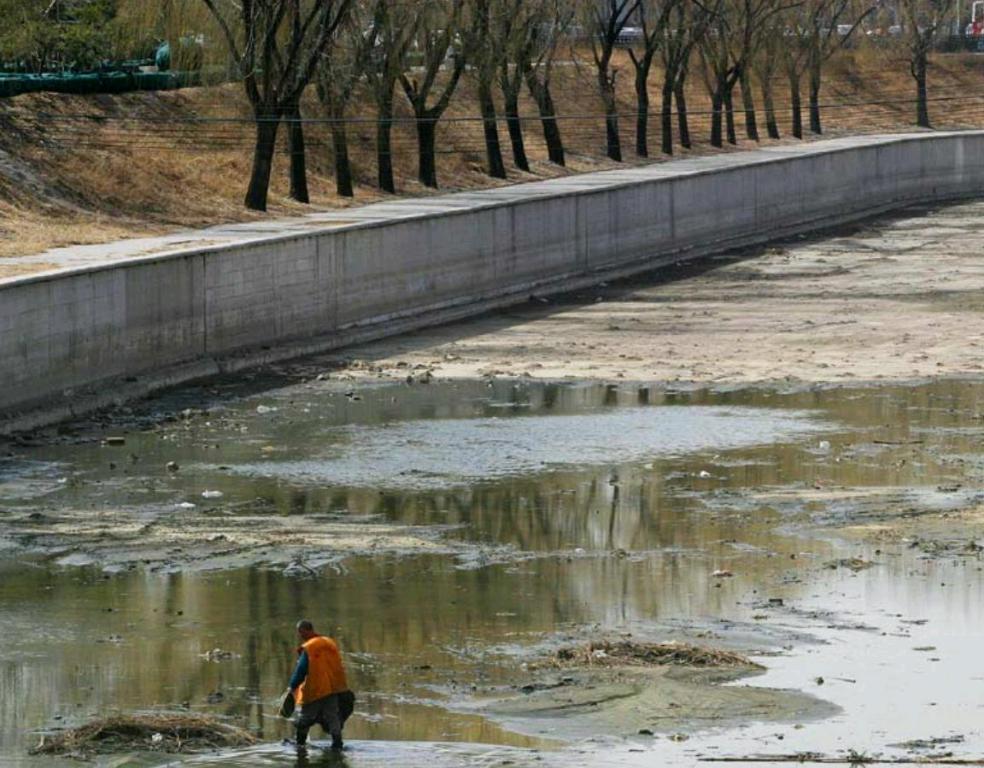Beijing Thirst
by+Deng+Qi
The month of June is considered Beijings rainy season. Even though successive days of rain last June bothered the public and aggravated traffic problems, employees of water suppliers felt a wave of relief. Because Beijings water supply is seldom cut off, local residents are not quite aware of the citys water problems or the fact that Beijing has been over-pumping groundwa- ter since 1999. In other words, the city is overusing its water resources to guarantee todays supply.
Water Shortage
Historically, Beijing was not a thirsty city. Situated in an area straddling semi-arid and semi-humid climates, Beijing boasts a thick aquifer and a layer of sandy gravel, which allow rainwater to quickly replenish underground reserves. It is not only hard to find an area in northern China with water conditions as favorable as Beijing, but even in the South.
However, today, Beijing is finally facing a water crisis, with less than 200 cubic meters of water per capita, less than three percent of the global rate. According to statistics issued by Beijing Municipal Water Supply Bureau, the city can replen-ish 2.1 billion cubic meters of water on average per year, while the total sum of water consumed each year has reached 3.6 billion cubic meters. In order to guarantee the water supply, since 1999, Beijing has begun extracting 500 million cubic meters of underground water on average per year, a total of 6 billion cubic meters so far. By the end of last January, the exhaustive exploitation caused underground water levels to drop 30 centimeters, which marked a decrease in underground water as great as 150 million cubic meters. In addition, a depression cone with an area of 1,000 square kilometers caused by underground water extraction has appeared in Beijings Chaoyang District. And even the backup water sources in Beijings suburban areas have dropped 40 meters underground compared to original levels of 10 meters when they were opened in 2003.
From 1999 to 2003, for five years in a row, Beijings annual precipitation measured less than 450 mm, much lower than its normal annual precipitation of 600 mm. Along with uncontrollable factors such as climate, human factors are also to blame for the citys water crisis. In particular, Beijings expanding size and rapid population growth cause so much consumption of water. Some water pollution events and emerging waterconsuming industries such as spas, car washes, golf courses and ski slopes have exacerbated the capitals water scarcity.
Borrow and Save
South-to-North Water Diversion, a project to relieve the water shortage in northern China, will be completed by the end of 2014 and ready to supply 1.05 billion cubic meters of water to Beijing every year. Despite considerable controversy, the project will greatly relieve water supply pressure in the capital.
Actually, preservation is more important. According to Li Hui, director of Beijings Water Saving Administrative Center, one Beijinger consumes 210 liters of domestic water a day on average, while the quantity for German people is 121 liters according to figures from the German Federal Statistics Office. Domestic water is primarily an absolute demand, with showering as the worst offender. Public water-conservation awareness is important for saving water, particularly habits such as turning off the tap while soaping, and using water-saving taps and toilets.
However, Ma Zhong, vice president of the Environmental Science College of Renmin University, believes that there is more room to save Beijings agricultural and industrial water. About 60 percent of agricultural water and 40 percent of industrial water is wasted because of leakage and evaporation. So, water-conservation requires a multi-channel approach.
Beginning in May, Beijing implemented a tiered pricing model for both domestic and industrial water consumption.“According to an investigation on household water usage, 4 percent of households consumed 15 percent of the total domestic water,” reveals Li Sufang, officer of Beijing Municipal Commission of Development and Reform. She believes pricing water in a tiered manner promotes fairness and prevents waste. “We should let the market play a bigger role and use pricing to enlighten households and enterprises about the citys scarcity of water,” remarks Yang Kaizhong, director of the China Regional Economy Research Center of Peking University.
Guo Jinlong, secretary of the Beijing Municipal CPC Committee, attributes the root of Beijings water problem to rapid and disorderly growth of its population. A city should maintain a reasonable population suitable for its resources. But maintaining the optimal scale of urban population has long been a problem for the capital. According to Beijings Urban Planning (2004-2020), the population of Beijing should stay under 18 million, but that baseline was already passed by the end of 2009, when the figure reached 19.72 million.
Given the comprehensive resource system, water is determining the limits of population Beijing can accommodate. “Like a barrel, its capacity is determined by the shortest board,” explains Yang. “In terms of Beijings resources, water is the shortest board. Compared to Tokyo, London and New York City, the flatland of Beijing is not small, so water rather than land has become the crucial factor restricting Beijings population. It takes strategy to determine Beijings population based on its water resources and coordinate the relationship between population and resources.”

